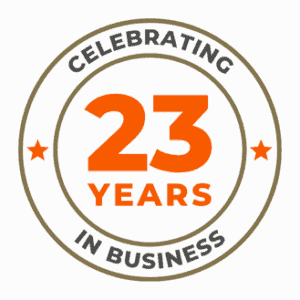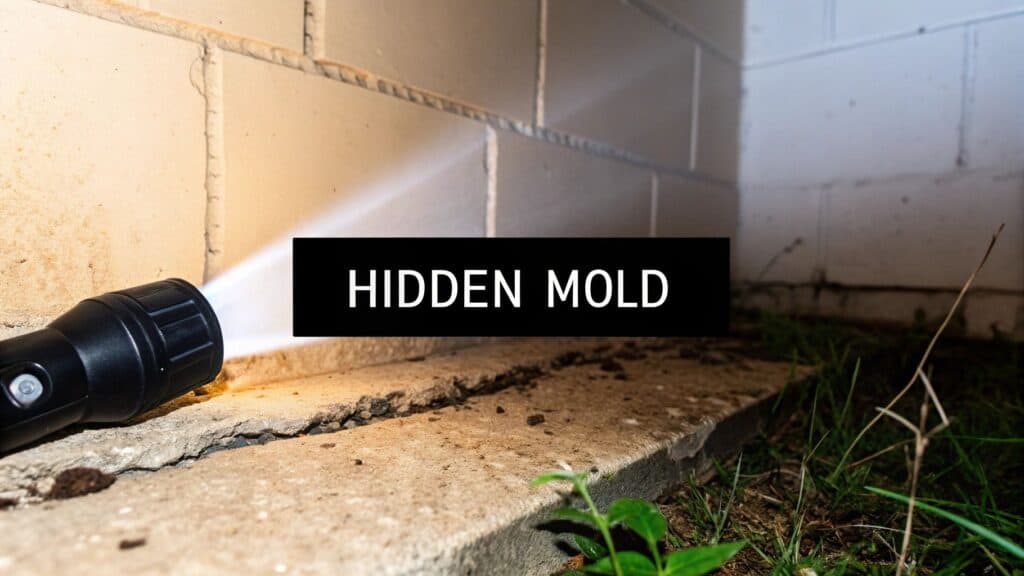That musty smell you can’t quite pinpoint, or the nagging allergy symptoms that flare up the moment you walk inside—these are often the first whispers of a much bigger problem: hidden mold in a house. It’s an unseen intruder, thriving silently behind your walls, beneath the flooring, or up in the attic. All it needs is a bit of moisture from a slow leak or the high humidity we often see here in Orange County, and it’s off to the races.
For discerning homeowners who value their property’s integrity and their family’s health, addressing this issue promptly is paramount. At Sparkle Restoration Services, we understand that your home is your most significant investment. Our mission is to provide the expert guidance you need to turn chaos into calm, fast.
The Sneaky Threat Lurking in Orange County Homes
When homeowners in Orange County think about threats to their property, their minds usually jump to earthquakes or wildfires. But a far more common and sneaky problem is often growing right under their noses. Hidden mold isn’t just an unsightly blemish; it’s a serious risk to your home’s structure and the health of everyone inside.
After two decades of serving homeowners from the coastal estates of Newport Beach to the exclusive neighborhoods of Irvine, we’ve seen how a tiny, unnoticed plumbing leak can quietly mushroom into a massive contamination problem requiring extensive remediation. Mold’s role in nature is to decompose organic materials, and it performs that job just as effectively on your home’s wood framing, drywall, and subflooring.
Why You Absolutely Cannot Ignore It
Delaying an investigation into potential mold is a recipe for more complex, stressful, and costly problems down the road. The longer you allow it to proliferate, the more havoc it wreaks on your property and well-being.
- Structural Damage: Mold literally consumes your house. Given enough time, it can weaken floor joists, rot drywall until it crumbles, and compromise the structural integrity of your home. These are not minor fixes; they are major, expensive repairs that require a licensed general contractor.
- Health Concerns: Certain molds produce mycotoxins, which are linked to a host of health issues. For many, it starts with what feels like a perpetual cold—coughing, sneezing, headaches. For children, the elderly, or anyone with a compromised immune system, the effects can be far more severe, impacting indoor air quality and overall wellness.
- Diminished Property Value: Discovering a significant mold issue during a pre-sale inspection can derail a real estate transaction or force you to drastically reduce your asking price. Proactively identifying and resolving it now is a direct investment in your home’s future value.
As IICRC Master Certified professionals and a BBB Torch Award Winner for Ethics, our primary role is to educate our clients. We believe that when you understand the risks, you are empowered to make informed decisions, turning a potentially chaotic situation into a calm, controlled process.
At Sparkle Restoration Services, we recognize that your home is your sanctuary. We are here to offer clear, expert advice so you can address any concerns about hidden mold with confidence and return to enjoying your home, worry-free.
Decoding The Subtle Warning Signs Of Mold
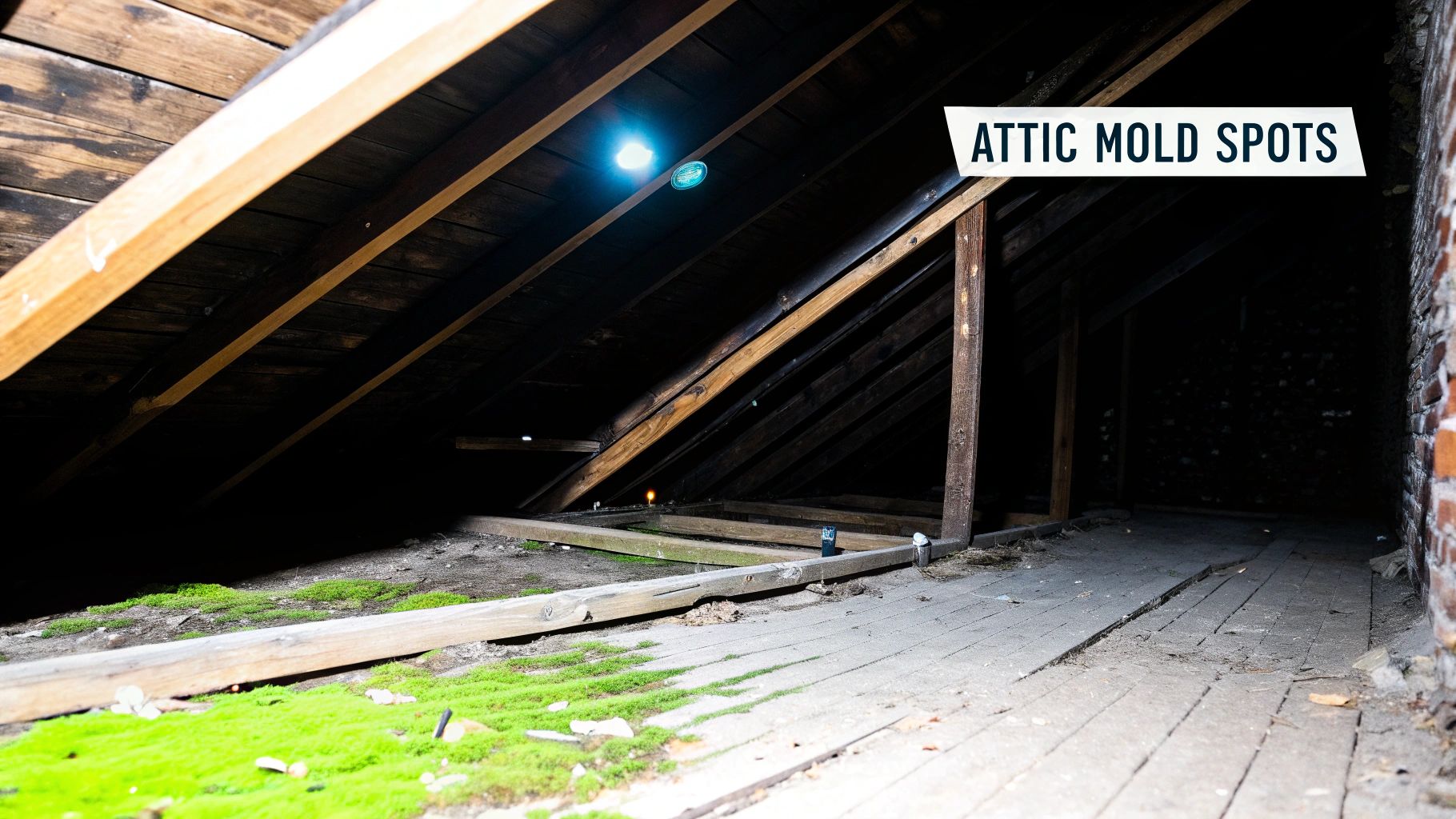
When it comes to finding hidden mold in a house, you must adopt a detective’s mindset. The most obvious clues are not always visual. In fact, the very first signal your home might send is an odor—a persistent, musty, or earthy smell that you cannot trace to the trash can or gym bag.
This signature scent is caused by Microbial Volatile Organic Compounds (MVOCs), which are gases mold releases as it consumes organic materials in your home. If that smell intensifies in a specific area, like a laundry room, basement, or bathroom, you are likely close to the source.
Physical And Visual Clues
Your own body can be a surprisingly effective mold detector. Do you find your allergies, asthma, or other respiratory issues flaring up at home, only to subside when you leave? This is a significant red flag. Persistent headaches, a nagging cough, or unexplained fatigue tied to your indoor environment are all worth investigating, as they can be linked to poor air quality. Our guide on indoor air pollution offers more context on this.
Beyond smells and symptoms, you must maintain a sharp eye for subtle visual changes around your property. These are often the tell-tale signs of the moisture that hidden mold requires to thrive.
- Wall and Ceiling Discoloration: Look for faint, yellowish, or brownish stains. They are easy to dismiss as simple water marks, but they could indicate a much larger problem behind the surface.
- Peeling, Bubbling, or Cracking: When paint or wallpaper begins to bubble or peel, it is often because trapped moisture is pushing it away from the wall.
- Warped Surfaces: Run your hands along baseboards, flooring, and even drywall. If an area feels soft, spongy, or appears warped, it is a strong indicator of moisture lurking behind it.
Real-World Example: We were called to a home in Irvine where the owners noticed their beautiful hardwood floors had started to buckle slightly in one corner of the living room. Our careful investigation, using non-invasive thermal imaging, revealed a slow, undetected pinhole leak in a pipe behind the wall. It had created the perfect damp environment for a significant mold colony to grow right under the subfloor, a situation we were able to fully remediate and restore.
This isn’t just an Orange County problem; it’s a global one. Studies show that moisture issues are incredibly common, affecting nearly half (47%) of homes in the United States with reports of dampness or mold. This staggering statistic underscores how critical it is to spot these early warning signs before a small issue becomes a massive restoration project.
Where Mold Hides: The Most Common Hotspots
As a licensed general contractor with decades of experience, I can attest that mold is a master of disguise. It doesn’t need sunlight or significant space to take hold. It only requires moisture, darkness, and an organic food source—like the wood, drywall, or even the dust prevalent in our homes. If you want to find a hidden mold in house problem before it becomes a nightmare, you must know where to look.
Think of it this way: any area in your home that has ever experienced a leak, dealt with condensation, or remains humid is a potential breeding ground. I’m not just referring to major floods. More often, it is the slow, insidious moisture that causes the most significant problems.
Behind Walls And Under Floors
The spaces you cannot see are where mold truly thrives. Behind drywall and beneath flooring is prime real estate for hidden growth. A tiny, pinhole-sized leak in a pipe can quietly release water for months, saturating the insulation and wood studs inside your walls. This is almost always the culprit behind musty odors that you can’t seem to pinpoint.
The same holds true for appliances. A slow leak from a dishwasher or the ice maker line on your refrigerator can seep under the floorboards, creating a hidden swamp where mold colonies flourish completely out of sight. By the time you notice warped flooring or a stain on the baseboard, the problem is usually far more extensive than you’d imagine. Many times, these hidden mold situations are a direct result of underlying moisture from common plumbing issues, especially in older Southern California homes.
The health risks tied to this kind of exposure are serious, which is why finding these hidden spots is so critical.
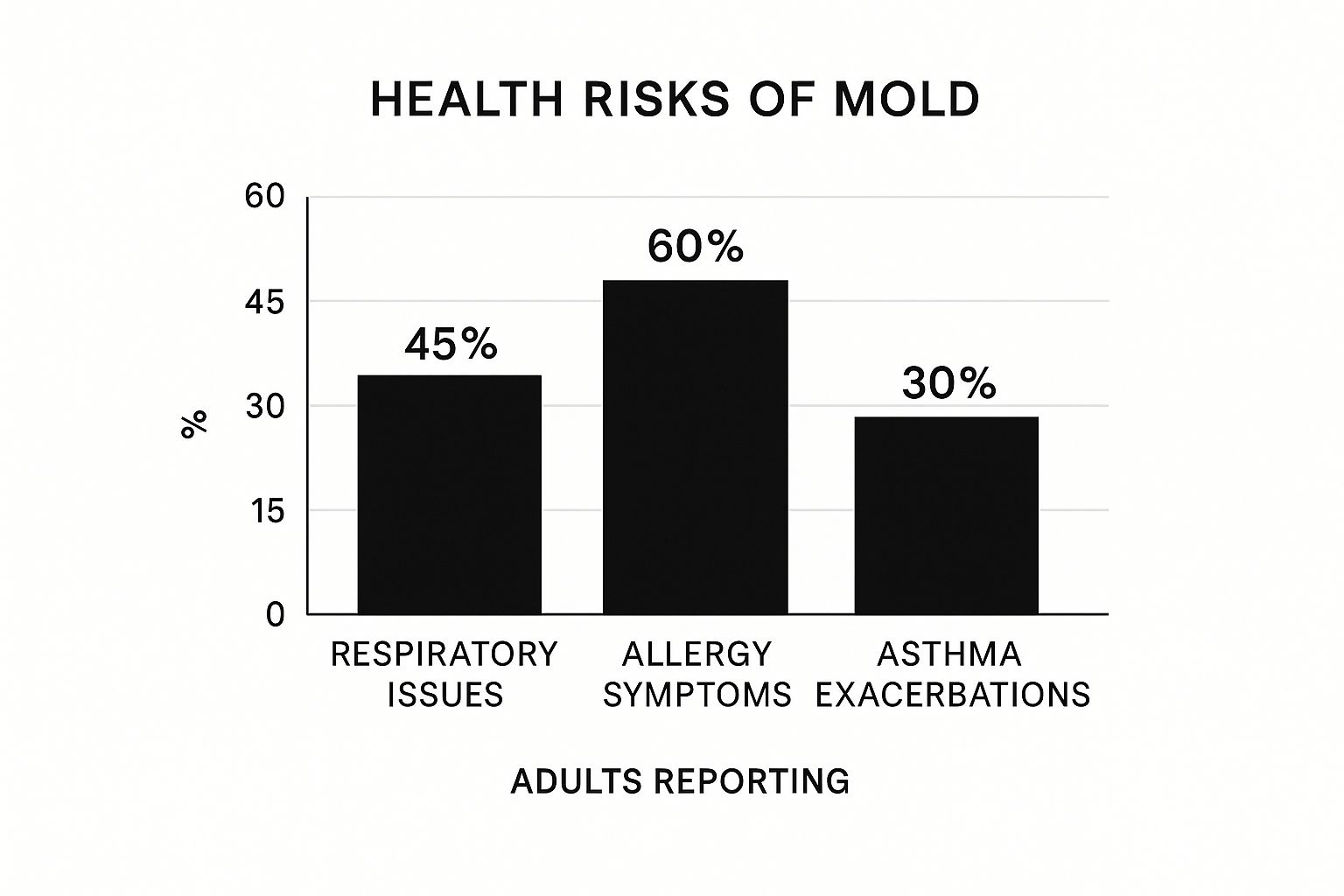
As you can see, a huge number of people suffer from allergy and respiratory symptoms that can be traced directly back to indoor mold. It’s not something to take lightly.
To help you get started, I’ve put together a quick reference table of the most common places I find hidden mold, what usually causes it, and what you should be looking for.
Common Hidden Mold Hotspots and Risk Factors
| Location | Common Moisture Source | What to Look For |
|---|---|---|
| Behind Walls | Leaky pipes, window leaks, condensation | Musty odors, peeling paint, warped drywall, stains |
| Under Sinks | Slow-dripping P-traps or supply lines | Dampness, wood discoloration, musty smell in cabinet |
| Under Floors | Appliance leaks, plumbing failures, foundation seepage | Warped floorboards, stained baseboards, soft spots in floor |
| Attics | Roof leaks, poor ventilation, ice dams | Damp insulation, dark stains on rafters, musty air |
| HVAC Systems | Condensation in drip pans or ductwork | Musty smell when system runs, visible growth on vents |
| Around Showers/Tubs | Failed grout or caulking, splash-out | Loose tiles, soft spots in wall, discolored grout |
This table covers the primary hotspots, but remember, mold can grow anywhere moisture persists. Always trust your senses and investigate any unusual smells or signs of water damage.
Kitchens And Bathrooms
It’s no secret that kitchens and bathrooms are high-risk zones. With constant water use and steam, they are a prime invitation for mold.
Here are the usual suspects I check first:
- Under Sinks: The dark, cluttered cabinet under the sink is a classic. A slow drip from a P-trap or supply line creates the perfect damp, dark environment.
- Around Showers and Tubs: When caulk or grout fails, even slightly, water can penetrate the wall behind the tile every time you shower.
- Behind Refrigerators: Drip pans and water lines can leak, and condensation builds where there’s no airflow, feeding mold growth directly on the wall.
HVAC Systems And Attics
Your HVAC system can become a superhighway for mold, distributing spores from one central point to every room in your house. If condensation builds up in drip pans or moisture gets trapped inside the ductwork, mold will grow and be circulated throughout your home.
Attics are another significant problem area, especially those with poor ventilation or a small, unnoticed roof leak. The trapped heat and moisture can turn the space into a perfect incubator. Identifying and eliminating the water source is the only way to stop the problem permanently. Our team specializing in water damage in Orange County is expertly trained to hunt down and eliminate these hidden moisture sources before they lead to a major mold issue.
How To Safely Investigate A Mold Concern

When you suspect there’s hidden mold in a house, the immediate instinct may be to start demolition or aggressive scrubbing. I understand the urgency. You want the problem gone. But an uninformed approach can backfire spectacularly.
The greatest risk is disturbing a hidden mold colony without proper containment. Doing so can release millions of spores into the air, turning a localized issue into a house-wide contamination nightmare and a far more costly project.
Your goal at this stage is not to be a hero and remediate it yourself. It’s to be a smart detective, gathering evidence safely. Your best tools for this initial assessment are a high-powered flashlight and your own hands.
A Safe Visual and Physical Check
First, conduct a non-invasive visual sweep of the high-risk areas we’ve discussed. Use your flashlight to inspect along baseboards, deep inside cabinets under sinks, and in the back corners of closets. You are looking for subtle signs—faint discoloration, peeling paint, or unusual textures on the wall that appear out of place.
Next comes the touch test. Gently press on drywall in suspicious areas, especially around plumbing or beneath windows where leaks often begin. Healthy drywall is firm and solid. If you feel any softness, a spongy texture, or a slight give, that is a red flag. You have likely found evidence of moisture intrusion—the fuel for mold growth.
Your objective here is simply to confirm a suspicion, not to begin demolition. Identifying a soft spot on a wall or tracing a musty odor to a specific cabinet is a significant discovery. It provides a certified professional with a solid starting point to resolve the underlying problem.
What You Must Avoid Doing
Knowing what not to do is as critical as knowing what to do. I have seen countless homeowners unintentionally worsen a situation by making two common mistakes.
- Don’t Tear Out Drywall: The absolute worst thing you can do is create an opening in the wall to “see what’s back there.” This immediately breaches containment, aerosolizing a massive cloud of mold spores. These spores can be drawn into your HVAC system and distributed to every room in your home.
- Don’t Rely on DIY Test Kits: The petri-dish kits sold at hardware stores are notoriously unreliable and misleading. They will almost always grow mold because spores are a natural part of our environment. What they cannot tell you is whether you have an elevated concentration, what type of mold is present, or where it is originating.
These kits can either provide a false sense of security or create unnecessary panic. They are no substitute for a professional assessment, which utilizes specialized equipment to develop a complete picture of your home’s indoor environment. Your role is to be an informed homeowner, not a DIY lab technician. Gathering clues safely is the smartest first step toward engaging the right expert help.
When To Call A Certified Mold Professional
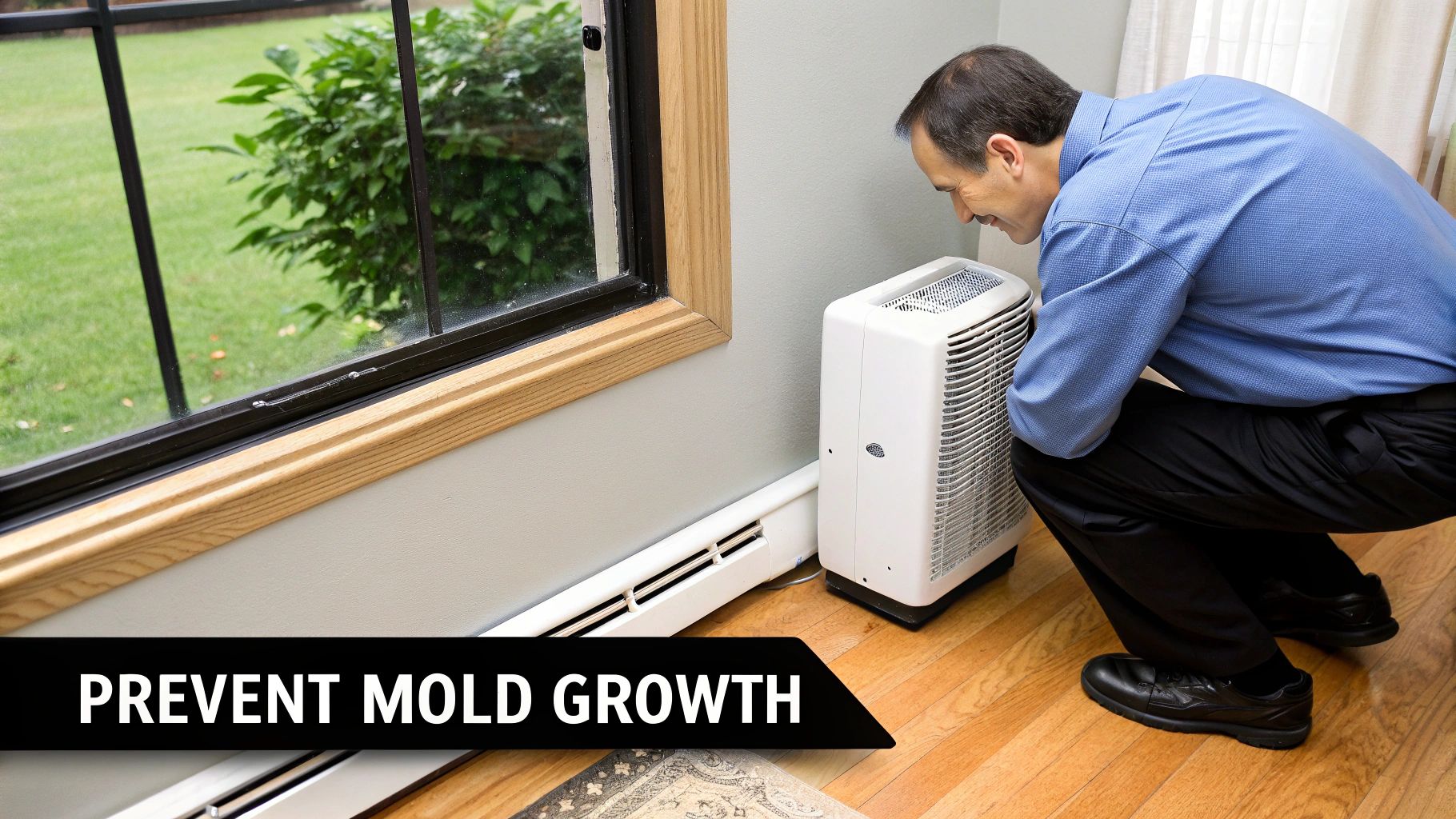
Knowing where to look for hidden mold in a house is one thing, but recognizing when to stop your investigation and engage an expert is just as crucial. A proactive homeowner can often spot the early warning signs, but there are clear triggers that mean it’s time to call in certified professionals. Attempting to tackle a significant mold issue on your own is not only ineffective but can be hazardous to your health and property.
So, when is it time to make the call? The moment you smell a persistent musty odor you cannot trace to an obvious source. Another major trigger is any visible sign of water damage—stains on the ceiling, warped baseboards, or drywall that feels soft.
And if you’ve experienced a major leak, flood, or plumbing failure? Do not wait. These events create an ideal breeding ground for mold and demand a professional response. These are not DIY problems; they are symptoms of a larger issue that requires an expert diagnosis.
The Sparkle Restoration Services Advantage
Choosing the right professional is everything. You need a team with proven expertise, not just in finding mold, but in understanding the complex science of building envelopes and moisture intrusion. This is where our unique qualifications provide unparalleled value.
As both an IICRC Master Certified firm and a Licensed General Contractor, Sparkle Restoration Services brings a level of technical authority that sets us apart in Orange County. We don’t guess; we use advanced, non-destructive technology to get definitive answers.
- Thermal Imaging Cameras: This state-of-the-art technology allows us to “see” behind walls by detecting temperature variations that indicate hidden moisture, all without destructive testing.
- Moisture Meters: We use specialized meters to get precise moisture readings in building materials like drywall and wood, confirming the true extent of the water intrusion.
This combination of elite certification and advanced technology means we can pinpoint the source and scope of your mold issue with surgical accuracy. From there, we develop a precise protocol for professional mold remediation to ensure the problem is eliminated at its source.
The True Cost Of Delaying Professional Help
Postponing a professional mold assessment is never a cost-saving measure. It is a fast track to escalating repair bills and potential health consequences. The longer mold grows unchecked, the more it degrades your home’s structure and compromises your indoor air quality.
Ignoring a mold problem is like ignoring a termite infestation—it only gets worse and more expensive over time. A professional assessment is a crucial investment in protecting your home’s structural integrity and market value.
The financial and health fallout from mold is significant. A 2012 report found that health problems linked to mold and dampness cost around 450 million euros each year. When you add in repair costs, that number jumps to about 1.4 billion euros annually. The same study revealed that roughly one in seven citizens were sensitized to indoor air compounds from mold exposure, which shows just how serious this hidden issue can be. You can discover more insights about these findings on TruthAboutMold.info.
Ultimately, only a certified professional can safely contain and remove existing mold while also correcting the underlying moisture source permanently. This comprehensive, integrated approach is the only way to truly turn chaos into calm and restore your home to a safe, healthy, and secure state.
Common Questions About Hidden Mold
Even after you know where to look and what signs to watch for, it’s natural for homeowners in Orange County to have lingering questions about a potential hidden mold in house situation. Getting clear, authoritative answers is the first step toward feeling in control.
Let’s address some of the most common questions we hear from our clients in Newport Beach, Irvine, and surrounding communities. Our goal is to arm you with expert-backed information so you can make confident decisions for your home and family.
Can I Just Clean The Mold I Find With Bleach?
This is the most frequent question we receive, and our answer is always an emphatic “no.” It’s a pervasive myth, but bleach is the wrong tool for porous surfaces like drywall, wood, or grout.
While bleach may decolorize the surface stain temporarily, the chlorine cannot penetrate deep enough to kill the mold’s root structure, or mycelium. Worse, bleach is primarily water. Applying it can actually feed the underlying mold, allowing it to grow back even more aggressively.
Professional remediation utilizes specialized, EPA-approved antimicrobial agents and follows strict containment protocols. This is the only method to ensure the complete and safe removal of the mold colony and prevent its return.
Are DIY Mold Test Kits From The Store Reliable?
DIY kits from hardware stores often cause more confusion than clarity. The reality is that mold spores are a natural component of our environment, indoors and out. Consequently, these petri-dish kits will almost always return a positive result for mold growth.
However, that positive result lacks the critical information you need. A store-bought kit cannot tell you:
- If you have an unusually high concentration of mold that indicates a genuine problem.
- The specific types of mold present, some of which are more hazardous than others.
- The exact location and source of the moisture feeding the growth.
A professional assessment from Sparkle Restoration uses targeted air and surface sampling combined with advanced moisture detection technology. This provides a precise, actionable map of the conditions inside your home. It is the only way to get the full picture and develop an effective solution.
What Does Mold Remediation Cost In Orange County?
The cost of professional mold remediation varies significantly. The final investment depends on the extent of the growth, its location, and the scope of repairs needed to correct the moisture source permanently.
For instance, a small, contained area of mold in an accessible cabinet will be far less complex and costly to resolve than extensive contamination hidden within walls or an HVAC system. At Sparkle Restoration, we are committed to 100% transparency. We provide a detailed, itemized estimate only after a comprehensive on-site evaluation, ensuring you have a clear plan that solves the problem at its root.
Will My Homeowner’s Insurance Cover Removing Hidden Mold?
Insurance coverage for mold removal depends entirely on your specific policy and the original cause of loss. Generally, if the mold is a direct result of a “sudden and accidental” covered peril—like a burst pipe—there is a strong possibility that your mold remediation will also be covered.
However, policies often exclude mold damage stemming from gradual issues, such as slow leaks, deferred maintenance, or persistent high humidity. As seasoned restoration experts in Orange County, we meticulously document all damage to build a robust case for your insurance claim. We always advise clients to review their policy first, then contact us for a professional assessment.
To help you separate fact from fiction, you can read more about common mold myths and remediation realities in our detailed guide.
When you suspect a hidden mold problem in your home, don’t leave it to guesswork. Your family’s health and your property’s integrity are far too important. The Sparkle Restoration Services team is here to offer the expert guidance and professional service you deserve. As an IICRC Master Certified firm and a BBB Torch Award Winner for Ethics, we are committed to turning chaos into calm, fast.
